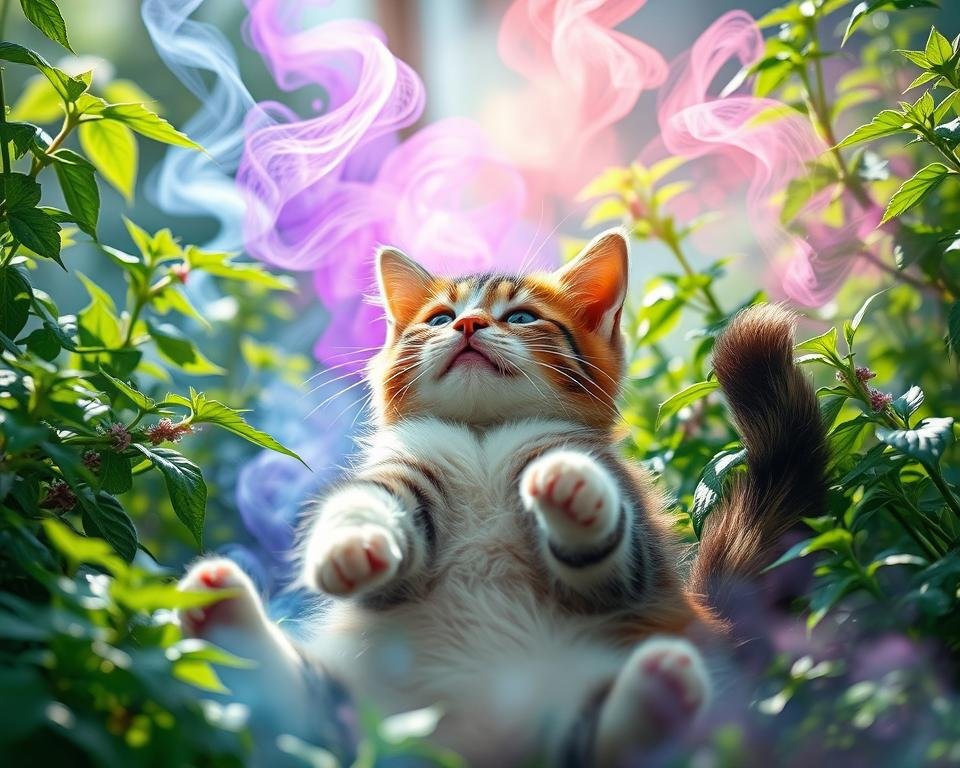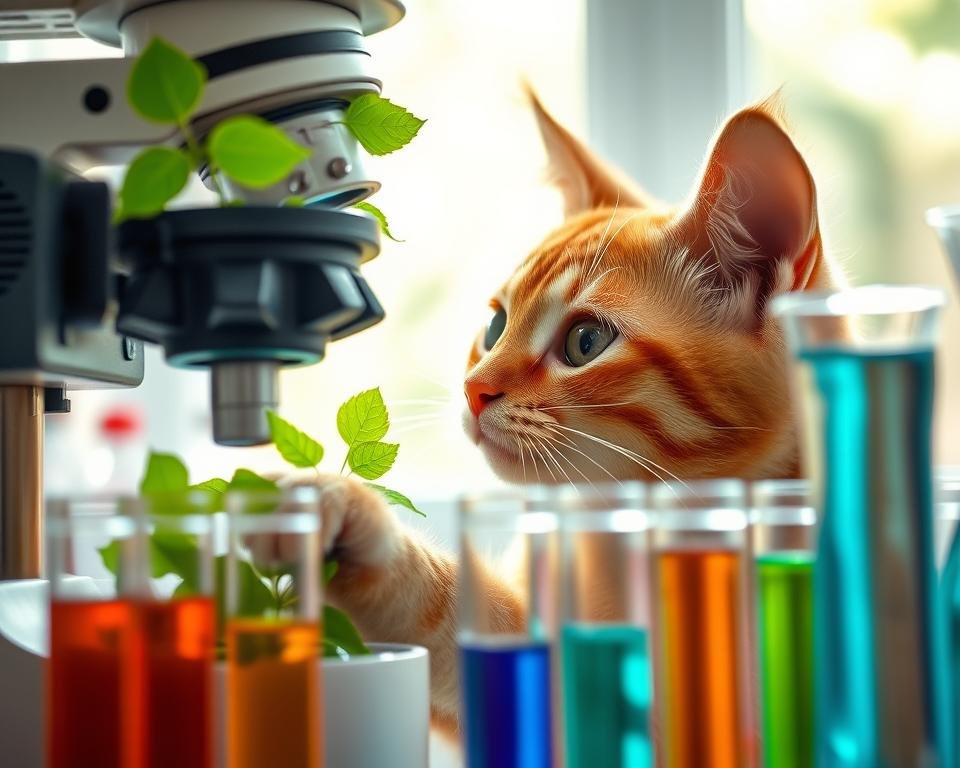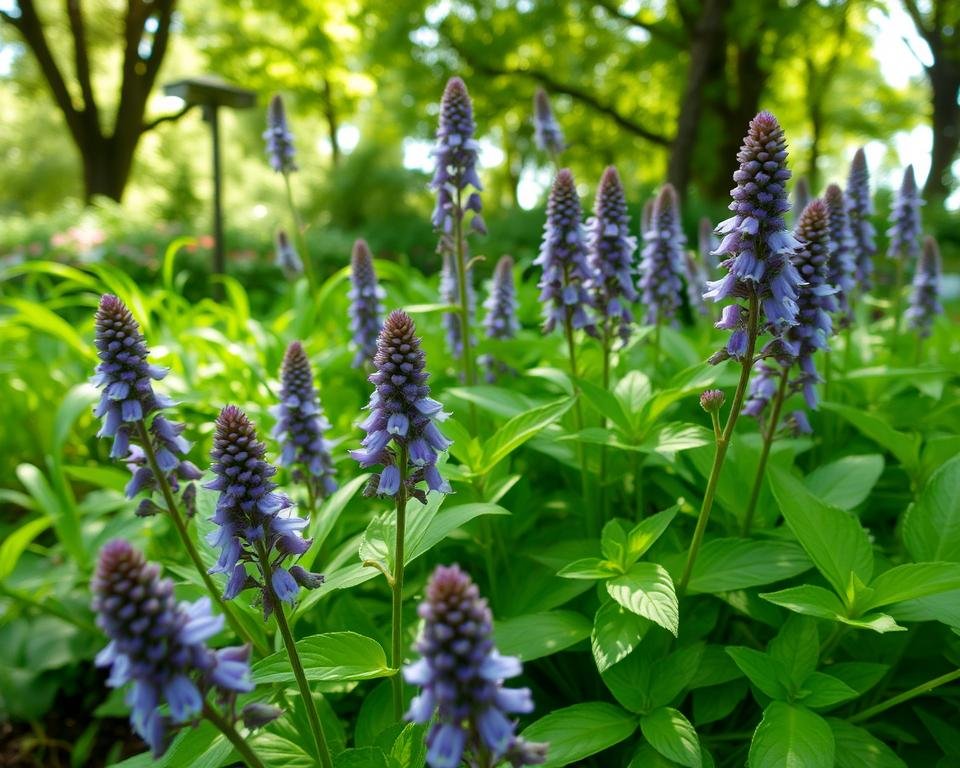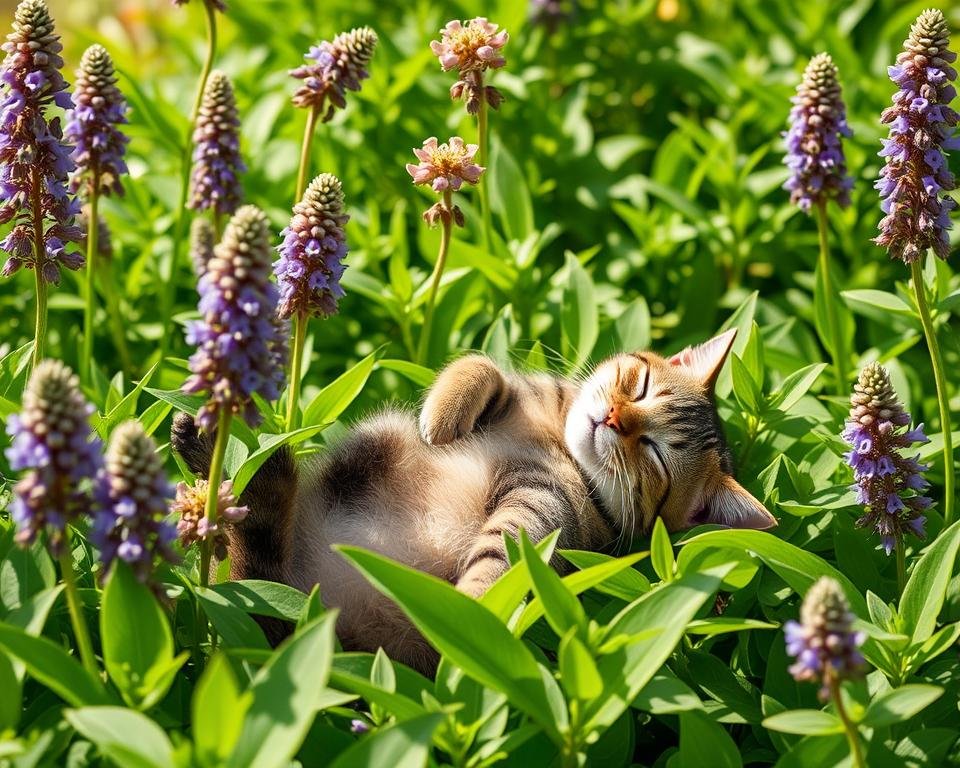Catnip is a fascinating herb that captivates cats and their owners. Known scientifically as Nepeta cataria, it can turn your cat into a playful, whimsical creature. In this guide, we’ll explore catnip’s origins, how it affects cats, and the science behind its aroma.
Key Takeaways
- Catnip is a fragrant herb that can induce a range of fascinating behaviors in cats.
- Cats respond to catnip due to a compound called nepetalactone, which interacts with their olfactory receptors.
- Catnip can stimulate playful, euphoric, and even mellow responses in cats, depending on the individual feline’s personality.
- Understanding the science behind catnip’s effects can help you better appreciate and manage your cat’s interactions with this captivating plant.
- Incorporating catnip into your cat’s enrichment routine can provide valuable mental and physical stimulation.
What is Catnip and How Does It Affect Cats?
Catnip, also known as Nepeta cataria, is a special plant in the mint family. It has a unique effect on many cats. The plant contains nepetalactone, a chemical that attracts cats.
Understanding the Allure of Catnip
Cats are attracted to catnip because of nepetalactone. When they smell it, the chemical binds to receptors in their noses. This sends a signal to their brain, causing them to act in different ways.
Catnip’s Effect on Cat Behavior
Watching cats with catnip can be fun. Some cats get very playful, rolling and jumping. Others relax, purring and kneading their paws. The effects last about 5-15 minutes, then the cat loses interest until it smells it again.
Not all cats like catnip. About 50-70% of cats can smell it and react. Kittens under 3-6 months usually don’t respond because their receptors haven’t developed yet.

Learning about catnip helps us understand our cats better. It shows us how fascinating their world is. By exploring catnip, we can appreciate our cats even more.
The Science Behind Catnip’s Potent Aroma
Ever wondered why cats go wild for catnip? It’s all about the science. Catnip’s special smell comes from a chemical called nepetalactone. This chemical is found in catnip leaves and stems.
When cats smell nepetalactone, it binds to special receptors in their noses. This sets off a reaction that makes them act strangely. They start sniffing, licking, and rubbing against the catnip.
| Compound | Percentage | Effect on Cats |
|---|---|---|
| Nepetalactone | 0.3% – 1.0% | Triggers a euphoric response, causing cats to sniff, lick, and rub against the catnip plant |
| Caryophyllene | 0.5% – 1.5% | Contributes to the plant’s distinctive aroma, but does not directly affect cats |
| Linalool | 0.1% – 0.3% | Also contributes to the aroma, but has no impact on feline behavior |
The science behind catnip is really cool. When cats smell catnip, nepetalactone molecules hit special receptors in their noses. This makes their brains release happy chemicals like dopamine and serotonin.
This is why cats act so strangely when they smell catnip. They start sniffing, licking, and rolling around. It’s a pretty funny sight.
But not all cats react the same way to catnip. It depends on the cat’s genes and how their brain works. Some cats just don’t care about catnip at all.

Identifying and Growing Catnip Plants
If you love cats and want to grow catnip at home, start by knowing what the plant looks like. Catnip, or Nepeta cataria, has square stems, serrated leaves, and lavender flowers. Once you spot the catnip plant, growing it indoors or outdoors can be a fun challenge.
Recognizing Catnip’s Distinctive Appearance
Catnip plants are usually 12-36 inches tall. They have fuzzy, heart-shaped leaves and square stems. The plant’s small white or lavender flowers bloom at the top. When you crush the leaves or stems, you’ll notice a strong smell that cats love.
Cultivating Catnip at Home
Growing catnip at home is easy. It likes sunny spots with well-drained soil and can start from seeds or cuttings. Plant seeds in the ground or containers and keep the soil moist until they grow. For cuttings, take a 4-6 inch stem, remove lower leaves, and plant it in moist soil. With the right care, your catnip will grow well and keep your cats happy.
| Catnip Cultivation Tips |
|---|
|
Learning to identify and grow catnip at home means you’ll always have it for your cats. It’s a great way to keep them happy and healthy.

Safe and Responsible Use of Catnip
As a cat owner, it’s key to know how to use catnip safely. This herb can make playtime fun for your cat. But, always put your cat’s health first.
For safe catnip use, a little goes a long way. Too much can make cats too excited or even aggressive. So, give them just a pinch or half a teaspoon at a time.
- Start with small amounts and watch how your cat reacts.
- Don’t give catnip too often, like more than a few times a week.
- Keep catnip away from your cat to stop them from getting too much.
Also, think about your cat’s age and health before giving them catnip. Kittens under 6 months should avoid it. Cats with heart or kidney issues might need to stay away from catnip too.
“The key to catnip safety is moderation and awareness of your cat’s individual needs and sensitivities.”
By following these tips, you can make sure your cat enjoys catnip safely and responsibly.
Catnip Toys and Treats for Enrichment
Offering your cat catnip toys and catnip treats can greatly enrich their life. These items satisfy their natural instincts and provide fun. They also help in relaxation and overall well-being.
Choosing the Right Catnip Products
When picking catnip toys and catnip treats, focus on quality and safety. Choose products with organic catnip for the best benefits. Also, ensure the toys are durable and safe, without choking hazards.
For the best catnip enrichment, offer a variety of items. This includes:
- Interactive catnip toys for mental and physical fun
- Plush catnip toys for comfort and texture
- Crunchy catnip treats for chewing satisfaction
- Catnip-infused scratching posts and pads for scratching
By choosing the right catnip toys and catnip treats, you create a fun and enriching space. This space promotes your cat’s happiness and well-being.
“Catnip is a game-changer when it comes to keeping your cat entertained and engaged. Embrace the power of this natural herb to provide your feline friend with endless hours of playtime and relaxation.”
Catnip Alternatives for Feline Playtime
Catnip is a favorite among cats, but there are other herbs and plants that can also excite them. These alternatives can make playtime more fun and engaging for your cat. Let’s explore some options to enrich your cat’s playtime.
Valerian Root: A Potent Feline Stimulant
Valerian root is a natural herb that acts like catnip for cats. It has compounds that make cats feel happy and energetic. It’s a great catnip alternative for cats that don’t like traditional catnip.
Silver Vine: An Ancient Asian Favorite
Silver vine, or matatabi, is a plant from Asia that has been used for centuries to entertain cats. It has actinidine, which makes cats playful and silly. It’s a good alternative to catnip for cats that don’t react to it.
Cat Mint: A Gentle Herbal Option
Cat mint, or nepeta, is a calming herb from the mint family. It’s a gentle what can I use instead of catnip option for cats. It may not be as exciting as catnip or valerian root, but it’s still enjoyable for cats.
| Herb | Effect on Cats | Availability |
|---|---|---|
| Catnip | Euphoric, playful behavior | Widely available |
| Valerian Root | Stimulating, energetic response | Widely available |
| Silver Vine | Euphoric, playful behavior | Limited availability in some regions |
| Cat Mint | Gentle, calming effect | Widely available |
Try these other herbs for cats to make playtime more fun. With so many options, you can find what your cat likes best. This ensures they stay happy and healthy.
Catnip’s Role in Cat Training and Behavior Modification
Using catnip can change the game in training and changing your cat’s behavior. It’s a natural and effective way to encourage good actions. It also helps you bond with your cat more deeply.
Using Catnip as a Positive Reinforcement Tool
Catnip is irresistible to cats, making it perfect for rewarding them during training. Give your cat a catnip treat or toy when they do something good. This teaches them to link certain actions with the joy of catnip.
Adding catnip to training makes it fun for both you and your cat. The excitement of getting catnip makes your cat more focused and eager to learn. This makes training easier and more enjoyable.
- Use catnip-infused toys or treats as rewards during training to encourage good behavior.
- Start using catnip as a positive reinforcement to shape your cat’s actions and improve their training experience.
- Try different catnip rewards to see what your cat likes best.
By using catnip as a positive reinforcement, you can change your cat’s behavior. This makes training successful and strengthens your bond with your cat.
“Catnip can be a game-changer in cat training, allowing you to positively reinforce desired behaviors and create a more engaging learning experience for your feline friend.”
Catnip’s Impact on Feline Health and Well-being
Catnip is a favorite for cats, but it also affects their health and happiness. Learning about catnip health effects and catnip and feline well-being is key. It’s important to know the good and bad sides of this plant.
Catnip offers a fun and safe way to keep cats happy and healthy. It helps reduce stress and boredom. This makes your cat’s life better and more balanced.
But, catnip isn’t risk-free. Too much or the wrong kind can cause stomach problems or change their behavior. Watch how your cat reacts and use catnip wisely.
“Catnip can be a wonderful addition to your cat’s enrichment routine, but it’s important to use it responsibly and with your feline’s health and well-being in mind.”
Knowing how catnip affects cats helps you use it right. With care and attention, you can make your cat happy and healthy.
Conclusion
Catnip is a fascinating plant that cats love. It has a special smell that affects their behavior. This guide has given you lots of useful information about catnip.
Catnip can make cats play or relax. You can grow it at home to benefit your cat. It’s also important to use catnip responsibly and find other fun activities for your cat.
Now you know a lot about catnip. You can use this knowledge to make your cat’s life better. This article will help you strengthen your bond with your cat.







Leave a Reply